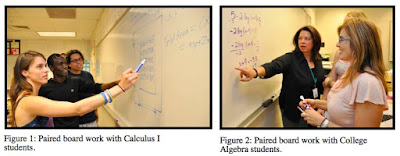In 2015, the MAA’s Committee on the Undergraduate Program in Mathematics (CUPM) produced its latest Curriculum Guide. Extensive as this was, including specific recommendations for most courses and programs offered in departments of mathematics, the steering committee that it left out a big part of what is needed for effective teaching. Spurred by the Common Vision report that outlined what we know about effective teaching and called for their implementation, CUPM set out to describe in detail examples of instructional practices that can greatly improve teaching and learning. The result is the Instructional Practices Guide (IP Guide), now available for free download from the MAA.
 |
| From the description of paired board work, page 20 of the IP Guide. |
Effective teaching and deep learning require student engagement with content both inside and outside the classroom.This puts the emphasis within the phrase “active learning” where its advocates have always intended it to be, on learning, employing those practices that foster higher order thinking skills.
The report is usefully divided into three sections: Classroom Practices, activities that can be used in the classroom to promote engagement with the material; Assessment Practices, how assessment can be used formatively and to probe student understanding; and Design Practices, which get to the broader questions of how to design courses that incorporate the classroom and assessment practices in ways that are most effective. It concludes with two short sections, one on the use of technology and one on equity issues.
Classroom Practices constitutes the longest section, describing how to build a classroom community, use wait time, respond to students, and promote persistence. This section includes explanations and examples of some of the standard techniques of active learning: one-minute papers, think-pair-share, just-in-time teaching, and peer instruction.
Almost as long as the section on Classroom Practices, Assessment Practices goes into detail on what effective, meaningful, and helpful assessment looks like and how it can be accomplished without overwhelming the instructor, even in large classes.
We now have overwhelming evidence of the importance of active cognitive engagement with the mathematics we want our students to learn. Those of us who have succeeded in mathematics have known how to do this outside of the classroom. Most students do not. Most students still approach mathematics as a sequence of templates to be learned for solving specific sets of problems. If we want them to learn anything that will stay with them beyond the term, any knowledge that is transferable, then we must structure our classes so that students are forced to wrestle with the material. The IP Guide should prove to be a useful resource as we reconfigure our courses to meet these goals.
References
Karen Saxe and Linda Braddy. 2015. A Common Vision for Undergraduate Mathematical Sciences Programs in 2025. Washington DC: MAA Press. https://www.maa.org/sites/default/files/pdf/CommonVisionFinal.pdf
Carol S. Schumacher and Martha J. Siegel, co-Chairs, Paul Zorn, editor. 2015. 2015 CUPM Curriculum Guide to Majors in the Mathematical Sciences. https://www.maa.org/sites/default/files/CUPM Guide.pdf
MAA. 2017. Instructional Practices Guide. https://www.dropbox.com/s/xpvkni52tkf0wgt/MAA_IP_Guide_V1-1.pdf?dl=0

No comments:
Post a Comment